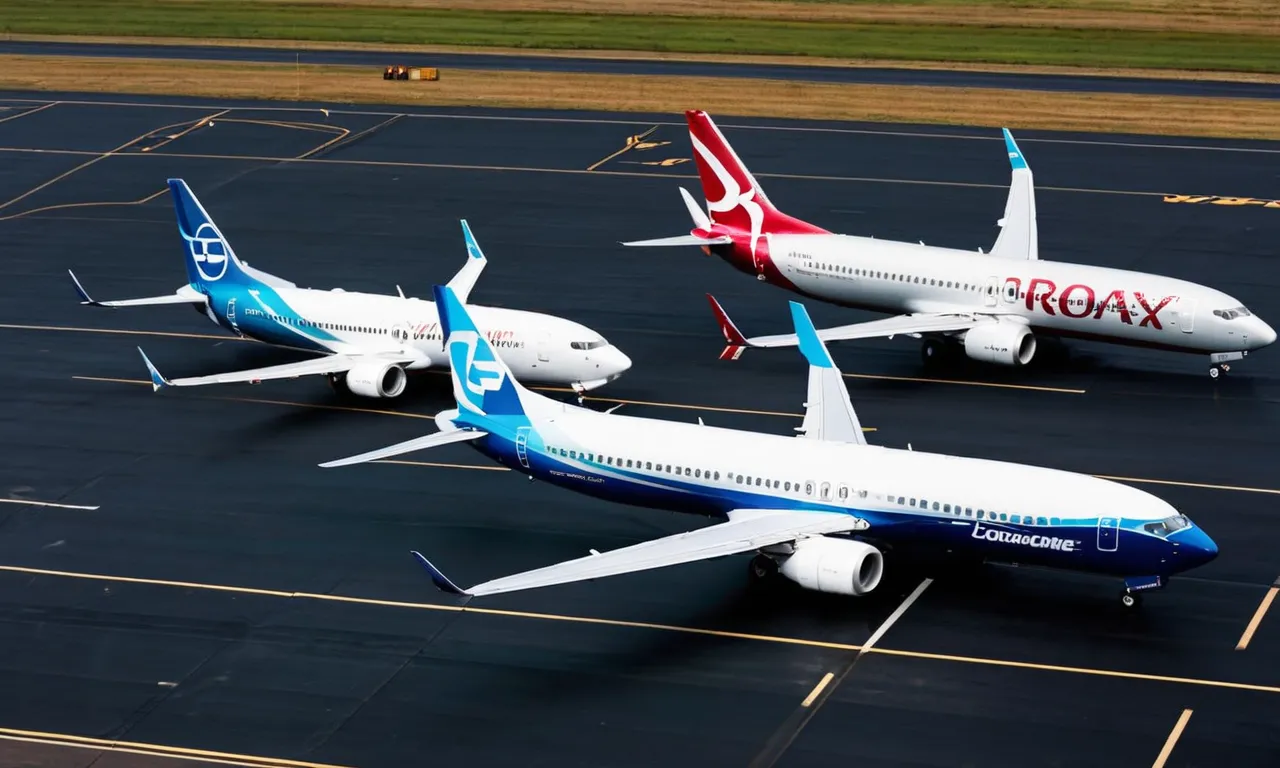Boeing 737-800 Vs Max: Key Differences Explained
Wondering about the Boeing 737-800 Vs Max difference? Well, you’ve come to the right place. In short, while both planes have had a reliable narrow-body jet, the newer 737 MAX was grounded after two deadly crashes exposed a critical software issue.
In this comprehensive guide, we’ll analyze the key distinctions between these two popular Boeing models across dimensions like design, technology, performance, safety, and more.
Background and Origins
When it comes to commercial aviation, few aircraft models have made a bigger impact than the Boeing 737 series. Over the years, Boeing has introduced several variants of the 737, each with its own unique features and improvements. Two of the most popular versions are the 737-800 and the 737 MAX.
Let’s take a closer look at the background and origins of these aircraft.
737-800 History
The Boeing 737-800 is part of the Next Generation (NG) series, which was introduced in the 1990s. It is a longer and more fuel-efficient version of the original 737-300. The 737-800 quickly gained popularity among airlines for its increased seating capacity and improved range.
It also incorporated advanced technology and enhanced safety features, making it a reliable choice for both short and medium-haul flights.
Since its introduction, the 737-800 has become one of the best-selling aircraft in Boeing’s history. Its success can be attributed to its versatility, passenger comfort, and operational efficiency. Airlines around the world rely on the 737-800 to transport millions of passengers safely and efficiently every year.
737 MAX Development
The development of the Boeing 737 MAX was an ambitious project aimed at further improving the efficiency and performance of the 737 series. Boeing incorporated advanced aerodynamics, lightweight materials, and more efficient engines to create a new generation of aircraft.
The 737 MAX was designed to compete with the Airbus A320neo series, which offered similar fuel efficiency and range. Boeing introduced two variants of the 737 MAX, the MAX 8 and the MAX 9, with the MAX 8 being the most popular model.
These aircraft promised even greater fuel efficiency, increased range, and improved passenger comfort compared to the 737-800.
However, the development of the 737 MAX faced significant challenges. In 2019, two tragic accidents involving the MAX 8 raised concerns about its safety. As a result, the aircraft was grounded worldwide for several months while Boeing and regulatory authorities worked to address the issues and ensure its safe return to service.
Boeing has since implemented a series of software and hardware updates to enhance the safety features of the 737 MAX. The aircraft has undergone rigorous testing and recertification processes to regain the trust of airlines and passengers alike.
It is important to note that the 737 MAX has faced scrutiny and criticism for the way the development and certification processes were handled. This has led to a reevaluation of safety procedures and regulatory oversight in the aviation industry.
Despite the challenges, the 737 MAX remains an important part of Boeing’s lineup, with airlines gradually reintroducing the aircraft into their fleets. The MAX series represents Boeing’s commitment to innovation and continuous improvement in the field of commercial aviation.
Physical Design and Dimensions
Fuselage
The Boeing 737-800 and 737 MAX share similar physical designs when it comes to the fuselage. Both aircraft have a narrow-body structure, which means they have a single aisle that runs through the middle of the cabin. This design allows for efficient boarding and deboarding of passengers.
The fuselage of both planes is made of lightweight materials, such as aluminum alloys and composite materials, to enhance fuel efficiency and reduce overall weight.
However, one key difference between the 737-800 and 737 MAX lies in their lengths. The 737-800 has a standard length of approximately 129 feet and 6 inches, while the 737 MAX comes in two variants: the MAX 8 with a length of about 129 feet and 8 inches, and the MAX 9 with a length of around 138 feet and 4 inches.
The longer length of the MAX 9 allows for increased seating capacity compared to the 737-800, making it a preferred choice for airlines with higher passenger demand.
Wings and Engines
The wings and engines of the Boeing 737-800 and 737 MAX also have some notable differences. The 737-800 features the CFM56-7 engines, while the 737 MAX is equipped with the more advanced CFM LEAP-1B engines.
These engines provide improved fuel efficiency and reduced emissions, making the MAX a more environmentally friendly option.
In terms of wingspan, the 737 MAX has a slightly larger wingspan compared to the 737-800. The MAX 8 and MAX 9 have a wingspan of approximately 117 feet and 10 inches, while the 737-800 has a wingspan of around 112 feet and 7 inches.
The larger wingspan of the MAX allows for better aerodynamic performance, resulting in improved fuel efficiency and overall flight performance.
It’s important to note that the 737 MAX underwent significant design changes compared to its predecessor, the 737-800. These changes were made to enhance the aircraft’s performance, fuel efficiency, and safety features.
The MAX incorporates advanced technology, such as the Boeing Sky Interior and the Advanced Technology Winglet, which further improve passenger comfort and fuel efficiency.
Avionics and Software Systems
When comparing the Boeing 737-800 and the 737 MAX, one of the key differences lies in their avionics and software systems. These systems play a crucial role in the overall performance and safety of the aircraft.
Cockpit Features
The cockpit of the 737-800 is equipped with advanced avionics systems that provide pilots with essential flight information. It includes a digital flight deck with primary flight displays (PFDs) and multi-function displays (MFDs).
These displays offer real-time data on various flight parameters, navigation information, and engine performance.
On the other hand, the 737 MAX takes cockpit technology to the next level. It features the latest Boeing Sky Interior, which includes larger displays and enhanced graphical interfaces. The primary flight displays in the MAX have been upgraded to high-resolution LCD screens, providing pilots with even more precise and detailed information.
Additionally, the MAX introduces advanced automation features, such as the integration of the Maneuvering Characteristics Augmentation System (MCAS).
Maneuvering Characteristics Augmentation System (MCAS)
The MCAS is a significant addition to the 737 MAX’s avionics and software systems. It is a flight control system designed to enhance the aircraft’s handling characteristics and prevent stalls in certain flight configurations.
The MCAS automatically adjusts the aircraft’s horizontal stabilizer trim to counteract the potential for a stall during high-angle-of-attack situations.
While the MCAS has been a subject of controversy and scrutiny following the accidents involving the 737 MAX, it is important to note that Boeing has made significant modifications to the system.
These modifications include additional layers of redundancy, improved training for pilots, and enhanced software updates to provide better situational awareness and prevent any potential malfunctions.
Pilots and aviation enthusiasts must stay updated with the latest information regarding avionics and software systems of different aircraft models. Websites like Boeing provide detailed technical information on their aircraft and the systems powering them.
Performance and Capabilities
Range
The Boeing 737-800 and the 737 MAX have different ranges, which refers to the maximum distance the aircraft can fly without refueling. The 737-800 has a range of approximately 3,060 nautical miles, while the 737 MAX has a slightly longer range of around 3,550 nautical miles.
This means that the 737 MAX can cover a greater distance, making it suitable for longer flights.
Fuel Efficiency
When it comes to fuel efficiency, the 737 MAX outperforms the 737-800. It incorporates advanced engine technology and aerodynamic improvements, resulting in a fuel consumption reduction of approximately 14% compared to the 737-800.
This not only reduces operating costs for airlines but also contributes to a lower carbon footprint, making the 737 MAX a more environmentally friendly option.
The fuel efficiency of the 737 MAX is partly achieved through the use of the CFM International LEAP-1B engines, which are specifically designed for this aircraft model. These engines feature advanced technology that enhances fuel burn and reduces emissions.
Additionally, the 737 MAX has winglets that improve aerodynamics and further contribute to fuel savings.
According to a report by the International Air Transport Association (IATA), fuel efficiency improvements in the aviation industry can have a significant impact on reducing greenhouse gas emissions. The use of more fuel-efficient aircraft like the 737 MAX can help airlines achieve their sustainability goals and contribute to a greener future for air travel.
For more information on the fuel efficiency of the 737 MAX, you can visit the Boeing website.
Safety Issues and Controversies
737 MAX Crashes
The Boeing 737 MAX faced significant safety issues and controversies following two fatal crashes. In October 2018, Lion Air Flight 610 crashed into the Java Sea, and in March 2019, Ethiopian Airlines Flight 302 crashed near Addis Ababa. These tragic incidents resulted in the loss of 346 lives.
The investigations into the crashes revealed a design flaw in the Boeing 737 MAX’s Maneuvering Characteristics Augmentation System (MCAS). This system was designed to automatically adjust the aircraft’s pitch to prevent stalling.
However, a faulty sensor could trigger the MCAS to repeatedly push the nose of the plane down, leading to a loss of control.
The crashes raised concerns about the certification process of the Boeing 737 MAX and the level of oversight by regulatory authorities. Questions were raised about the training provided to pilots regarding the MCAS and their ability to handle emergencies related to this system.
The incidents also highlighted potential issues with the aircraft’s software and the need for robust safety protocols.
Aftermath and Measures
In the aftermath of the crashes, the Boeing 737 MAX was grounded worldwide. Aviation authorities and airlines took immediate action to ensure the safety of passengers and restore public confidence. Investigations were conducted to determine the cause of the accidents and identify necessary improvements.
Boeing implemented various measures to address the issues and enhance the safety of the 737 MAX. This included updating the MCAS software to prevent it from receiving erroneous inputs and providing additional training for pilots on how to handle MCAS-related emergencies.
The company also improved the aircraft’s sensors and made changes to the flight control system.
Regulatory agencies, such as the Federal Aviation Administration (FAA), closely scrutinized the modifications made by Boeing and conducted thorough reviews before allowing the 737 MAX to return to service.
They implemented stricter certification processes and emphasized the importance of transparency and collaboration between manufacturers and regulators.
It is important to note that the Boeing 737-800, the predecessor of the 737 MAX, has a strong safety record and has been widely used by airlines around the world for many years. The safety issues and controversies surrounding the 737 MAX led to significant improvements in aviation safety protocols and highlighted the need for continuous vigilance in the industry.
For more information on the Boeing 737 MAX and its safety measures, you can visit the official Boeing website and the FAA updates.
Boeing 737-800 Vs Max – Conclusion
In closing, the 737 MAX shared marked similarities with the reliable 737-800 but was equipped with more modern engines and avionics.
While issues with its MCAS software proved disastrous, leading to the MAX’s 20-month grounding, Boeing has worked to rectify problems and prevent future accidents as the jet returns to widespread service.








